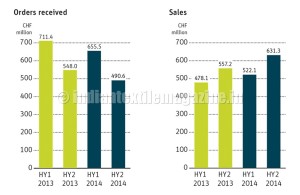Double-digit growth in 2014
Rieter took full advantage of the market dynamics in 2014 and improved its market share, thanks to successful products and extended presence in Asia. The company achieved double-digit sales growth with a particularly strong performance in the second half of the year. Sales increased by a total of 11 per cent to 1 153.4 million CHF. Orders received during the year amounted to 1 146.1 million CHF.
Rieter had a backlog of orders in hand of around 730 million CHF at the end of 2014. This means a high level of capacity utilisation until well into the 2015 financial year.

In the market for short-staple fibre machinery and components, the positive trend of the previous year continued, albeit with the different characteristics of the individual economic regions. Overall, demand was above the average of previous years, although momentum slowed in some important markets in the second half of the year.
Rieter took full advantage of the trend in the flourishing countries and significantly increased sales compared to 2013, thereby benefiting from the significant strategic investments in China and India in previous years. Today, the company is able to offer products at the highest quality level from all its locations. Thus, the company further improved its leading position in 2014.
Orders received
New orders received by the Rieter Group reached the level of sales in 2014. Compared to the strong previous year, orders received decreased by nine per cent to 1 146.1 million CHF (2013: 1 259.4 million CHF). A large number of orders came from Asian countries where spinning mill capacities were built up to supply the Chinese textile markets, from Turkey and the US. The positive trend in India continued throughout the year under review. In China demand was subdued, as in the previous year.
In the favourable market environment of the first half of the year, Rieter recorded significantly higher order intake than in the more challenging second half. The decline in the second half of the year was mainly attributable to lower orders from Turkey and China, and affected Rieter’s machinery business more than its components business.
At Spun Yarn Systems, orders received decreased by 10 per cent to 973.8 million CHF, compared to the previous year (2013: 1 084.3 million CHF). Premium Textile Components almost equalled the previous year’s level, with orders of 172.3 million CHF (2013: 175.1 million CHF).
Rieter had a backlog of orders in hand of around 730 million CHF at the end of 2014 (December 31, 2013: around 765 million CHF), which means a high level of capacity utilisation until well into the 2015 financial year.
Sales
As expected, sales by Rieter developed strongly in the year under review and increased by 11 per cent to 1 153.4 million CHF (2013: 1 035.3 million CHF). In the second half of the year, sales increased by 21 per cent compared to the first half. Rieter reported the highest increase in the US, followed by Turkey, India and various Asian countries.
In contrast, sales in China and Africa decreased compared to the previous year. Spun Yarn Systems increased sales by 14 per cent to 980.9 million CHF (2013: 857.8 million CHF). Premium Textile Components posted sales to third parties of 172.4 million CHF (2013: 177.5 million CHF). Segment sales, i.e., including deliveries to Spun Yarn Systems, increased by one per cent to 262.1 million CHF. Significantly supported by its extended capacities in Asia, Rieter achieved a record output of spindle equivalents.
Rieter expects to achieve an EBIT margin of a good seven per cent and net profit of about 4.5 per cent of sales in the 2014 financial year.
Swiss franc exposure reduced
In recent years Rieter has invested increasingly in the Indian and Chinese markets, as well as expanding production capacity in the Czech Republic. The global manufacturing concept has enabled the company’s flexibility to be improved and its exposure to the Swiss franc to be reduced compared to 2011.
Whereas Rieter still invoiced 53 per cent of sales in Swiss francs in the 2011 financial year, figures in 2014 were: 40 per cent of sales in Swiss francs, 37 per cent in euros and 23 per cent in US dollars and local currencies. Costs denominated in Swiss francs were reduced to some 34 per cent of sales (2011: some 43 per cent of sales). Rieter expects increasing pricing pressure on sales invoiced in Swiss francs in the 2015 financial year.

